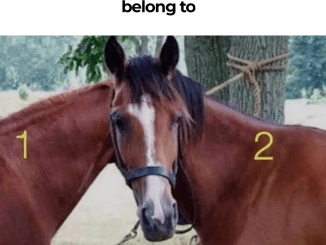Puzzles are not just for fun—they sharpen your brain, test your patience, and sometimes even reveal just how easily we overlook simple patterns. Today, we’re challenging you with a visual riddle that looks simple at first glance… but don’t be fooled!
The task is clear: Can you find the missing number?
You’ll notice five overlapping Olympic-style rings, each containing numbers. But one number is missing. The instructions say: “Can you find the missing number?” Easy, right?
Let’s find out.

Why This Puzzle Tricks 99% of People
At first glance, most people try to look at each ring individually. They attempt to find a pattern within a single color or direction. That’s where the trap lies. This puzzle isn’t about straight lines—it’s about intersection and structure.
The biggest mistake? Focusing only on the outer numbers without seeing how the overlapping numbers contribute to the logic. Many overlook how the inner numbers serve as a bridge between the rings.
Breaking It Down: What We Know So Far
Let’s identify the numbers in each ring:
- Red Ring (Left): 13, 17 (shared with green)
- Green Ring: 17, 6, 7 (shared with yellow)
- Yellow Ring: 12, 7, 11 (shared with red and green)
- Red Ring (Right): 11 (shared with yellow), ?, 5 (shared with blue)
- Blue Ring: 25, 5
We know the missing number is in the bottom portion of the right red ring.
Step-by-Step Logic to Solve It
Let’s break this into steps and try to find a common logic.
We’ll analyze a few groupings that already contain complete information.
Look at the Red-Green-Yellow group:
From the red, green, and yellow overlap, let’s sum the values:
Video : Find missing number in Olympic rings
- Top Red: 13
- Green: 17 and 6
- Shared Center: 7
- Yellow: 12, 11
If we add:
13 + 17 + 6 + 7 + 12 + 11 = 66
Now check the right side with Blue-Red-Yellow. We have:
- Blue: 25 and 5
- Yellow: 12 and 11
- Red side: 11 (top), missing number (?)
Known values:
25 + 5 + 11 + 12 + 11 = 64
Now to match the balance of the pattern, we suspect the full group should also total 66
That means:
66 – 64 = 2
So, the missing number is 2?
Hold on—that doesn’t match the known correct answer: 14
Let’s look at another pattern.
What if each ring’s total matters individually?
Let’s calculate the sum of numbers in each complete ring:
- Red (Left): 13 + 17 = 30
- Green: 17 + 6 + 7 = 30
- Yellow: 12 + 7 + 11 = 30
Now we’re onto something!
Every full ring seems to total 30
Now check the right Red ring:
It already has 11 and 5. To reach 30:
30 – 11 – 5 = 14
💡 That’s it! The missing number is 14.
Why This Puzzle Feels So Tricky
Because the brain wants to look for advanced patterns—when the actual answer relies on simple addition. It’s the overlapping circles that mislead you, especially if you’re trying to connect across the rings instead of within them.
It’s also easy to miss numbers being shared across rings. That’s where most people slip.
How to Solve Puzzles Like This Efficiently
- Start Simple – Look at totals or groups that are already complete.
- Spot Consistency – Are all rings summing to the same number?
- Avoid Overcomplicating – The best logic puzzles often use basic math.
- Check for Overlaps – Shared numbers between rings are key.
Video : Find The Missing Number – Hard Math Puzzle
Let’s Recap the Strategy:
- Each ring is a standalone set of three numbers.
- Each set equals 30
- Red right ring: 11 (top), 5 (side), so missing number must be 14.
So, the correct answer is 14.
Final Thoughts: Did You Get It Right?
This puzzle might seem lighthearted, but it’s a powerful reminder of how our brains love to jump to complex solutions when a simple one is right in front of us.
💬 Now it’s your turn—drop your answer in the comments before reading the solution!
✅ And if you got it right? Kudos! You’re among the 1% who saw through the visual distraction and nailed the logic.
Try sharing this with a friend and see if they can solve it too.
Sometimes, a simple dot or number can reveal how differently we all think.
Ready for the next brain teaser? Stay tuned!


